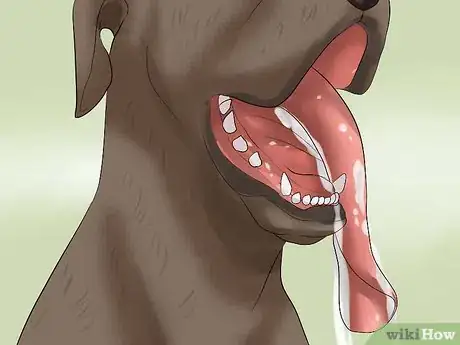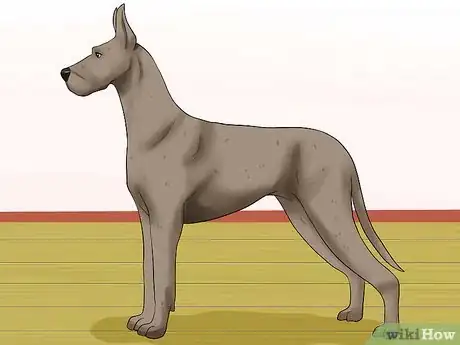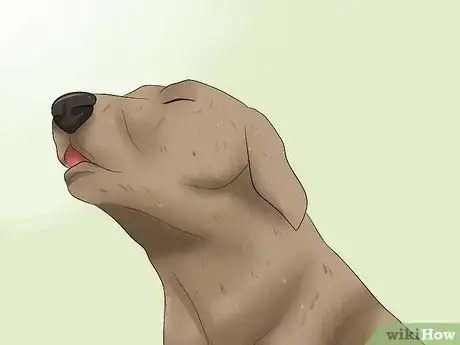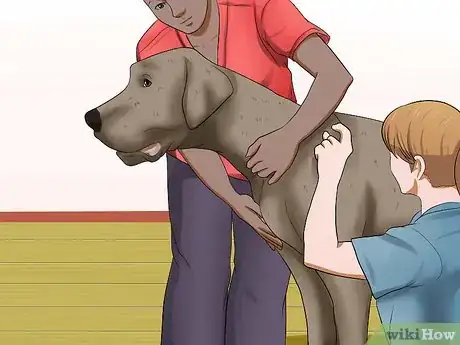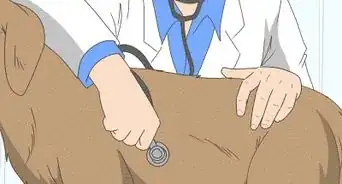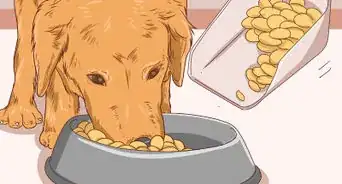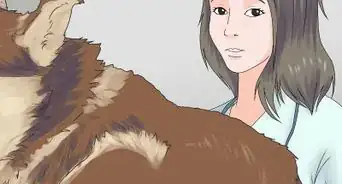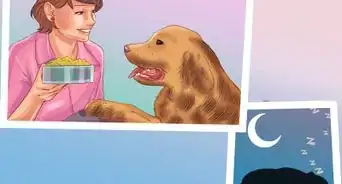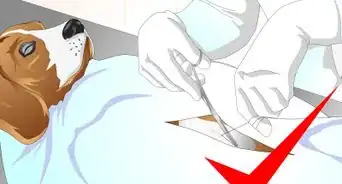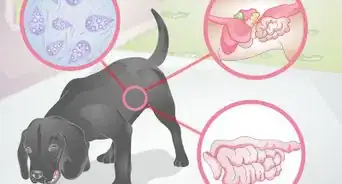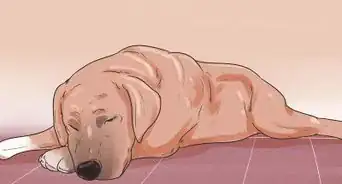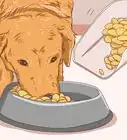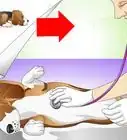This article was co-authored by Pippa Elliott, MRCVS and by wikiHow staff writer, Jessica Gibson. Dr. Elliott, BVMS, MRCVS is a veterinarian with over 30 years of experience in veterinary surgery and companion animal practice. She graduated from the University of Glasgow in 1987 with a degree in veterinary medicine and surgery. She has worked at the same animal clinic in her hometown for over 20 years.
There are 9 references cited in this article, which can be found at the bottom of the page.
This article has been viewed 53,492 times.
Have you noticed your Great Dane acting restless or uncomfortable? If you see a change in behavior along with swelling of his abdomen, he may have bloat (also known as gastric torsion, twisted stomach, Gastric Dilatation-Volvulus (GDV). Bloat is a potentially life-threatening condition. Large breed dogs such as Great Danes, Irish Wolfhounds as well as other large chested dogs are predisposed to because of the additional space it creates in their abdomen. Great Danes are by the most common breed to get bloat and was shown to occur in over 42% of all Great Danes.[1] The stomach can swell or become twisted during several stages while your dog rapidly deteriorates. Be aware of the symptoms of bloat and get immediate veterinary help. This will give your dog the best chance of survival.[2]
Steps
Watching For Signs of Bloat
-
1Look for swelling. Your dog's stomach may be swollen if it makes a tympanic, drum-like sound when you flick it. This means the stomach is full of gas. While swelling is the most obvious symptom of bloat, it can be difficult to spot in Great Danes because of their large size. If you're unsure whether your Great Dane has a swollen stomach, discuss your concerns with a veterinarian rather than wait for symptoms to improve. Early treatment of bloat can greatly increase chances of survival.[3] Increasing stomach pressure may lead to:[4] [5]
- Swelling
- Closing of the stomach so that it becomes sealed full of air
- Shutting down of blood supply to the stomach wall
- Decreased blood supply to major organs
- Organ failure
- Toxin buildup in the blood stream
- Shock from major swings in electrolytes and blood pressure
- Death from low blood pressure and toxin buildup
-
2Check your dog's mouth. Lift up your Great Dane's lips and look at his gums. They should be a healthy pink color and color should quickly return if you press the gums and release your finger. If you notice pale or ashen gums or the gums remain blanched white after you press them, your dog may have bloat.
- If your dog's gums are unusually dark red, blue, or white, get medical attention immediately.[6]
Advertisement -
3Pay attention to breathing and pulse. Your dog may have bloat if he has labored breathing that sounds heavy and rapid. It might sound like your dog is panting instead of breathing. If he has bloat, your Great Dane's pulse will also be rapid as though he just exercised.[7]
- Under normal conditions, a Great Dane's heart rate is around one beat per second. He should also breathe every two to three seconds during rest.[8]
-
4Watch for drooling. Your Great Dane may drool heavily and have strings of saliva hanging from his mouth. This happens when the stomach is sealed off, leaving swallowed saliva nowhere to go. The Great Dane gives up swallowing and drools instead.[9]
- You may also notice your dog dry retching. If your dog has eaten recently, but is dry heaving contact a veterinarian immediately. This is a classic sign of bloat.
-
5Consider your dog's body type. Dogs that are deep chested and narrow-bodied are at high risk of bloat. Because of their unique anatomy, Great Danes are at the highest risk of suffering from bloat. A Great Dane's large stomach is suspended in only two places within the abdomen, like a hammock. If the stomach is full of food and gas, it can become unstable and flip over on itself, especially if the Great Dane exercises or rolls after eating.[10]
- Other breeds that are at high risk for bloat include: German Shepherds, Irish Setters, Red Setters, St. Bernards, and Weimaraners.
Diagnosing Bloat
-
1Monitor your dog's behavior. Most noticeably, your Great Dane may be uncomfortable and unable to settle. He may also look anxious and frequently glance at his flanks, where you might notice swelling as air fills his stomach. As the bloat worsens, your dog may become increasingly distressed. He may whine or howl to vocalize his pain and discomfort. If untreated, he will go into shock and might collapse as his circulation system fails.[11]
- Bloat is usually associated with recently eating a meal. After eating, you may notice your Great Dane become restless and pace around.
-
2Contact a veterinarian. If you suspect your dog has bloat, get veterinary attention immediately. Call or meet with the veterinarian to discuss your Great Dane's symptoms. Since early treatment is vital, it's better to be overly cautious and get medical attention as soon as you see signs of bloat.
- Even with veterinary care, around 25-33% of dogs with bloat die, so early treatment is important.[12]
-
3Get a physical examination. The veterinarian will feel your dog's abdomen for signs of tympany (gas build up) and check for signs of shock. If bloat is suspected, the veterinarian might insert a large bore catheter into the stomach where there's the greatest buildup of gas. This will remove the immediate pressure.[13]
- Your Great Dane probably has bloat if foul smelling gas comes out through the catheter.
-
4Get further testing. The veterinarian may want to confirm a diagnosis of bloat with additional testing. In one test, your Great Dane will lay on his side while an x-ray is taken of the front of his abdomen. The veterinarian may confirm bloat if the x-ray shows a stomach dilated with air and soft tissue running across it.
- The veterinarian may also order an ultrasound to look at the location of the spleen. However, it's more likely that the vet will want to begin relieving stomach pressure and corrective surgery instead.
References
- ↑ https://www.ufaw.org.uk/dogs/great-dane-gastric-dilatation-volvulus-syndrome
- ↑ Canine gastric dilatation - volvulus syndrome in a veterinary critical care unit. Brockman. JAVMA 207 (4)
- ↑ http://www.peteducation.com/article.cfm?c=2+2090&aid=402
- ↑ Small Animal Internal medicine. Nelson & Couto. Publisher: Mosby.
- ↑ Canine gastric dilatation - volvulus syndrome in a veterinary critical care unit. Brockman. JAVMA 207 (4)
- ↑ http://www.ohiodanerescue.com/medical/bloat.htm
- ↑ http://www.vetstreet.com/dr-marty-becker/what-is-normal-dog-temperature-heart-rate-and-respiration?page=2
- ↑ http://www.vetstreet.com/dr-marty-becker/what-is-normal-dog-temperature-heart-rate-and-respiration?page=2
- ↑ http://pets.webmd.com/dogs/gastric-volvulus-bloat-dogs



